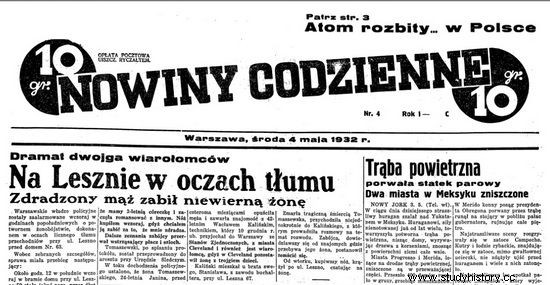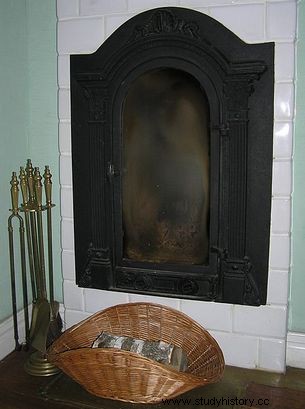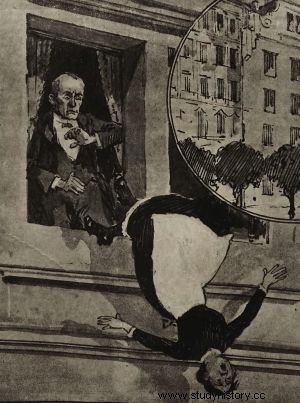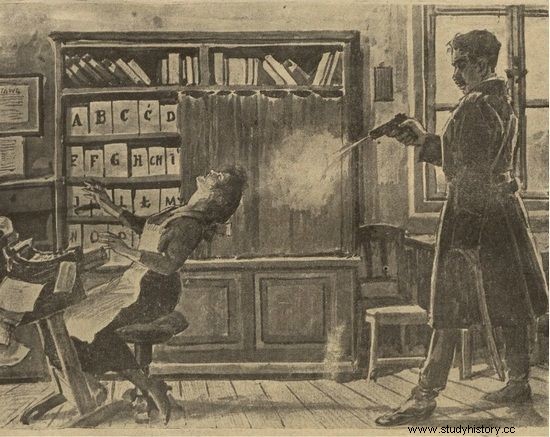In pre-war Poland, getting a legal divorce was a miracle. Many spouses did not want to wait for the court verdict or pay exorbitant sums for the church annulment of the wedding. They cut the marriage knot quickly and efficiently - with a revolver or a knife stab.
The press reported continuously on such matters. The most common theme? Betrayal, of course. On May 4, 1932, Nowiny Codzienne wrote about a crime that happened the day before in Leszno Street in Warsaw. Around noon, a couple left the gate of house number 59:a man in his forties and a woman in his twenties. Discussing lively, they walked towards Żelazna Street. Suddenly:
a man standing on the pavement next to the road, taking a huge kitchen knife from his coat pocket in a flash, threw himself on the people walking and dealt a strong blow to the woman's neck. The injured woman fell to the pavement without even moaning.

The Warsaw Daily News reported the crime committed by Wacław Tomaszewski on the first page.
Knife in love
There was a panic in the street. People ran away, shouted and called the police in panic. Meanwhile, the perpetrator stood still over the inert body of a dying woman. When he finally woke up, he called: You may not call the police, I will go to the police station myself! The officers were faster, however, and after a few minutes they arrested the cutthroat. It turned out to be 31-year-old Wacław Tomaszewski. He testified to the duty officer:
I killed my wife because she ran away from me in January even though we have a 3-year-old daughter and started having an affair with another. I bought the knife yesterday because I wanted to kill her for cheating on me.
Significantly, the paper did not stigmatize the killer at all. You might even get the impression that she justifies the murder. Journalists emphasized that the wife - 24-year-old Janina - had indeed left her husband four months ago and entered into a relationship with a returnee from the United States, who is also an infidel. The husband was only defending his marital rights…
Husband burned in the furnace
Of course, the killer was not always the one who was betrayed. Often it was the cheating side of the relationship who wanted to get rid of the uncomfortable spouse. This is what happened in Orłowo near Kutno, where the gardener Władysław Pawełkiewicz lived with his wife and two children. The wife of Pawełkiewicz got into an affair with a distilled man who, despite his advanced age, was endowed with quite a temperament.
The case is surprising because the distilled man - Leopold Hejmanowski - confessed to Pawełkiewicz and even persuaded him to move out and accept a job as a gamekeeper in another town. You can see the gardener (a calm and sedate man) has already written off his marital life. The more difficult it is to understand what happened on New Year's Eve in the early 1920s.
Pawełkiewicz disappeared like camphor after a libation organized by Hejmanowski. There were no signs of the crime, so the police didn't even investigate. Because maybe the man just left without a trace? Maybe he forgot about his wife and kids, made his life somewhere else?
In the end, however, after almost six years, Hejmanowski talked about everything over a glass of vodka. As "Nowiny Codzienne" wrote:
He confided in [a] worker about his relationship with Pawełkiewiczowa. He said that the mistress shot her husband in his apartment and he took the corpse to the boiler room and burned it in the furnace there.

Perhaps the body of the unfortunate Władysław Pawełkiewicz was burnt in a similar furnace (photo:Beentree; Creative Commons 3.0 license).
Hejmanowski's language was loosened for a reason:Pawełkiewiczowa had just broken up with him and the man was afraid that he would sometimes be reported to the police. He asked the aforementioned worker - Kazimierz Garstka - to provide him with an alibi, if necessary. Apparently, however, he chose the object of confession wrong, because Garstka ran straight to the police with the information he obtained.
Hejmanowski and Pawełkieczowa were immediately arrested. During the interrogations, the distilled man blamed all the blame on his mistress. The mistress, on the other hand, held him responsible and maintained that, on her part, she only helped to burn the corpse in the boiler room.
The court found her more credible:Hejmanowski was sentenced to life imprisonment for murder, and Pawełkiewicz was stuck only a year for hiding the body. Moreover, the sentence was not upheld. He wandered through successive instances, and finally the Supreme Court overruled him. "There is no body, no crime," the members of the Supreme Court decided.
Accusation after ten years
The crime in Inowrocław caused fewer complications. In 1931, the local court heard a case against Weronika Tarkowska and her lover Władysław Olejniczak, accused of murdering Weronika's husband, Józef Tarkowski. The Secret Detective reported on a fairly typical case in the April 26 issue:
The act was done by Olejniczak at the urging of Weronika Tarkowska, who had long sought to remove her uncomfortable husband from her path. Olejniczak hid under Tarkowski's bed and when the latter fell asleep, coming out of his hiding place, he choked him with a rope. It was delivered to him by Weronika, who also actively participated in the murder. After the hearing, the court accepted the guilt of both defendants.
A real black widow from that Tarkowska street. There was no shortage of similar ones in Poland, although some of them were much better masked. A high-profile case came to light near Trzebon (Greater Poland) in 1936. A certain Kowalska reported to the police that her husband had murdered his first wife ten years ago. According to Dziennik Poranny, the case was as follows:Franciszek Kowalski got into an affair with the sister of a certain Maślankowski.
Knowing that it would be very difficult to obtain a formal divorce, he decided to get rid of his sick wife. He strangled the unsuspecting woman, and then, with the help of his mistress and her brother, carried the body to the river. There he arranged the corpse in a way that made it impossible to determine the cause of death (with his head submerged in water; the medical board was unable to determine whether there was a murder or a suicide.

Ordinary accident or… divorce?
Released from his obligations, Kowalski soon married his mistress. Unfortunately for him, after ten years the spouses quarreled over the property. The wife was so upset that she went to the police to take revenge on her husband in an unconventional way. But she showed him! Kowalski might have cursed her in the following years in prison.
He killed because he was a wimp?
Sometimes, of course, the murders took place for much more trivial reasons. If things were not going well in the marriage herd, a single word could lead to a bloody ending. In October 1933, Nowiny Codzienne wrote about the case of the Napałowski family from Targówek. It wasn't a successful relationship from the very beginning:
Napałowska did not love her husband, and she was fond of her first fiancé, Aleksander Brzeziński. So she soon began to leave her husband's house and eventually moved completely to her lover.
Not only did she refuse to return home, but she also did not allow her husband - Czesław Napałowski - to join their two-year-old child.
The desperate man had already decided that he would commit suicide, but he wanted to try again to talk to his wife, moreover, in her lover's apartment. The meeting definitely did not go his way: Napałowska treated her husband's last offer harshly, claiming that he was too small for her when she liked tall men and that no woman would like such a dwarf.
Dwarf ?! This one insult filled the cup of bitterness. Napałowski reached for a revolver and fired two shots from close range, laying his wife dead. Then he shot himself in the lungs, but the ambulance somehow saved him. The court treated him extremely gently:the man was imprisoned for a year and a half.
Divorce attorney with revolver in hand
Alcohol was also a particularly frequent motive of the crime. After the vodka, even the most orderly citizens had their minds escaping. The would-be murderer turned out to be, for example ... a former investigating judge and a successful divorce attorney! For a extremely puzzling and mysterious accident took place in Praga in May 1932 and was reported by "Nowiny Codzienne".
The main character was the aforementioned lawyer, Anatol Ivanov. A month earlier, he had rented an apartment at 7 Inżynierska Street. Ksenia Cherkasov, 22, lived with him. Apparently the girl was his wife, although it is hard to believe. She did not bear the surname of Ivanov, and in the registration books she was entered as "a maid with the family" (that is, an unmarried tenant). So she was sooner the concubine of your attorney.

In the Second Polish Republic, the courts were extremely lenient towards the killers of adulterous wives. Especially when they insulted their husbands. The case of Czesław Napałowski was the best proof of this.
The ill-fated day Ivanov returned home around four in the morning. He was completely flooded, and demanded from Cherkasova to pay the card debt he had just incurred. There was a loud argument, in which the girl took Ivanov's revolver and ran to the balcony. The drunken lawyer rushed after her, so Cherkasova quickly threw the gun into the yard. Apparently, she feared that the cohabitant might try to shoot her, if not kill her. However, it did not work - the revolver was picked up by the caretaker of the tenement house and ... he immediately gave it to Ivanov.
Another armed Ivanov was about to attack a terrified woman who, taking refuge in the bathroom, broke the window and hung on the windowsill. After a few minutes, her strength left her and, unhappy, she fell on the roof of the cell, where she was found by one of the tenants of the house.
A neighbor called an ambulance to Cherkasova, which took the bruised woman to the hospital. The police arrived in the morning. The officers placed Ivanov in custody at the disposal of the judge. Of course, none of the lawyer's former colleagues was going to arrest him. As a result, he was released on the same day. The adventure was probably good for him - from then on he could tell every client of his law firm that he perfectly understood what problems at home are ...
Sources:
The article is based on source materials and literature collected during the work on the book "Upadłe damy II Rzeczpospolitej".
